 Pay-per-click (PPC) managers love remarketing. At first glance, this makes perfect sense, as it enables marketers to easily improve their return on advertising spend (ROAS) numbers.
Pay-per-click (PPC) managers love remarketing. At first glance, this makes perfect sense, as it enables marketers to easily improve their return on advertising spend (ROAS) numbers.
But is it really money well spent?
Recently, we performed an audit for a multinational retailer with a specific concern: improving new customer growth. Things developed nicely, there were no performance issues and ROAS more than doubled as spend increased slightly.
But digging a little deeper, we noticed something interesting. Remarketing lists for search audiences (RLSA) traffic had spiked and retargeted website visitors accounted for half of all sales.

That wasn’t all. While ROAS picked up, their new customer rate decreased by almost 50 percent!
Obviously not what finance asked for. This unwelcome reality means a slow growth of new customers leading to limited repeat purchases and shrinking future profits.
So, what does this mean? If you win few new customers, it stands to reason that you can expect fewer repeat customers.
Retargeting known users ostensibly yields great performance. And using RLSA helps marketers reach ROAS targets effortlessly. It looks seriously good on paper, but could it be too good to be true?
How RLSA helps
We set out to discover how much RLSA helps with new customer acquisition and overall incremental revenue — the metrics that truly matter to your business.

Besides the fact that it tends to address existing customers only, retargeting raises another concern: Does RLSA truly have a bottom-line, incremental impact? Ask yourself:
- How many people would have bought my product without seeing the retargeting ad?
- Which portion of my paid performance would have come in through non-paid channels anyway?
- Am I paying for traffic that I might have received without any advertising pressure?
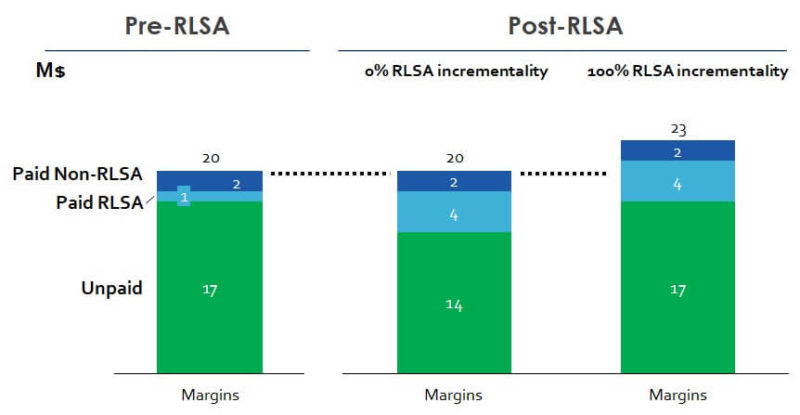
In the example above, it becomes clear that if RLSA were 100 percent incremental, we would add to our total revenues. If it had no incrementality at all, we would (silently) just decrease the share of unpaid traffic.
The reality falls somewhere in between. Before saying more, let’s examine our industry’s addiction problem.
The industry can’t get enough of retargeting
Why is there such an addiction to RLSA in our industry?
It’s simple: A higher RLSA share means performance marketing managers can present their bosses greater numbers and higher revenues at the same cost. For agencies, it means higher budgets and perhaps even higher fees.
And so it stays as popular as ever. Retargeting has also proven addictive for the search engines; they get premium prices for clicks that occur through the channel.
Let’s take retail e-commerce as an example. According to Alphabet’s earnings report, this sector accounts for around 24 percent of total PPC revenue. And an estimated 30 percent of retail spend comes via RLSA — generating several billion dollars in earnings for Google in 2017.
![]()

Taking this a step further, we tested enhanced cost per click (ECPC) against manual bidding. Base bids on RLSA increased by 23 percent against the control group. Compare this to a mere 16 percent increase in non-RLSA cost per clicks. Viewed more closely, this increase came from lower-funnel audiences (such as cart abandoners) which show the best key performance indicators (KPIs).
Effective cost per click is machine-learning-oriented. It optimizes the KPIs you provide via AdWords, and these numbers don’t reflect incrementality. Because of this focus on ROAS, Google tries to achieve what you ask it to do, which, in turn, makes you retarget more and more.

KPI pointers
When it comes to your target KPIs, a couple of pointers can help.
- Stay skeptical. If results appear too good to be true, they probably are. This holds especially true when evaluating for ROAS (Remember, it doesn’t consider new customer acquisition or incrementality). Be mindful that you automatically retarget users anyway, even without RLSA.
- Administer an incremental health-check, since appearances can be deceptive. The better the numbers you see, the less incremental they may be. Why not test for yourself? Measure incrementality for RLSA, brand and PPC as a whole.
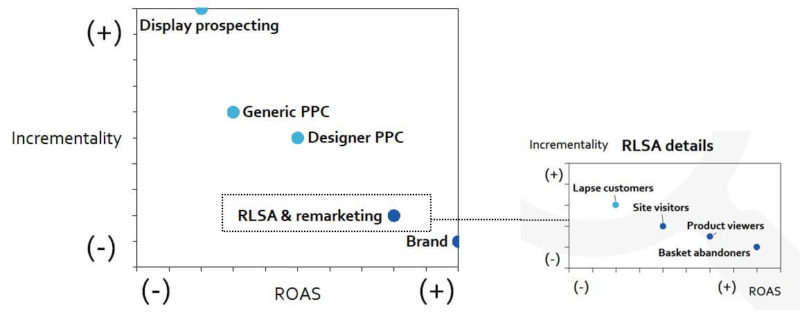
This chart shows the relation between incrementality and ROAS.
Why does high ROAS usually mean low incrementality? Because you’re targeting users who already know your shop and are likely to have bought there previously.
These users naturally have the highest conversion rates. But they’re also the ones most likely to return through unpaid channels. So why spend extra budget?
Testing incrementality using Google Analytics
So, what are some best practices for testing the incrementality of RLSA? We recommend using analytics data versus engine data; this controls for the natural cannibalization often found in AdWords.

Set up an A/B test with ad exposure as the variable to test:
- A random split of your audience is best practice for assuring test reliability.
- All other factors being equal, any differences in the groups’ results can be attributed to ad exposure.
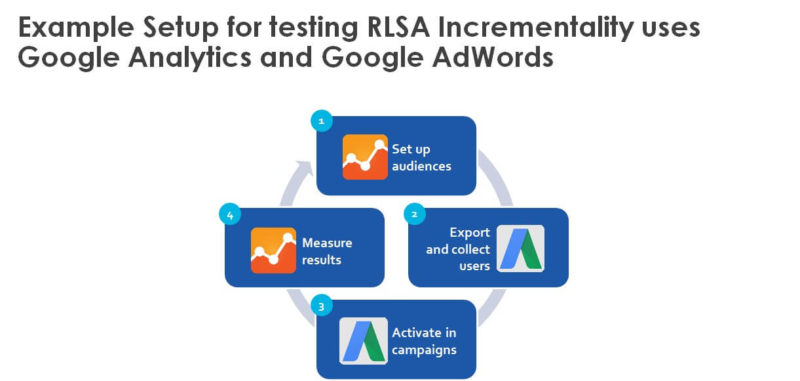
- Set up random audiences using Google Analytics’ user bucket dimension.
- Export your Google Analytics audiences to your AdWords ad groups and collect data for search eligibility.
- Add lists to campaigns to reflect test design… and activate.
- Measure results using Google Analytics’ custom report.
Step 1: Randomizing website visitors as test and control group
In Google Analytics’ Audience Builder, select “Condition” followed by “User Bucket”:

Next, set up your desired group size. For two groups of the same size, assign 50 buckets each.

Step 2: From Analytics to AdWords
Finalize your audiences in Google Analytics and export. The “Users over last 7 days” option will give you an initial impression of the list’s volume. Assign a name to the audience (see 2) and finalize the Audience Builder work by choosing a destination for the audience — in this case, AdWords (see 3).

Once in AdWords, you’ll have to wait for the list to collect enough users to become eligible for search retargeting (see 4).
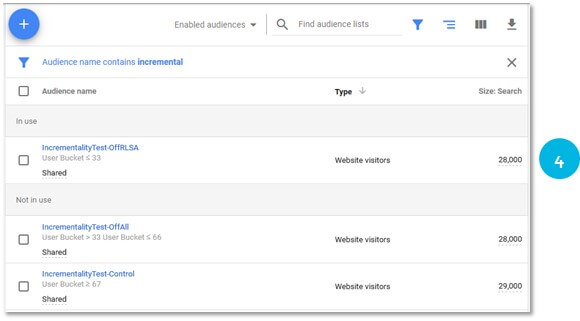
Step 3: Combine each existing list with randomized audiences
To differentiate between Treatment and Control groups:
- Once your audiences have collected a sufficient volume of users, you can start the test.
- Add both lists to your campaigns. Next, exclude the users of one list from AdWords, while boosting the other by 100 percent.
- To avoid cannibalization, no other lists should be active. Important point: If your current performance relies heavily on RLSA, the test should not run on the entire account, as it is likely to impact efficiency. In this case, choose a few campaigns that have high traffic — but not enough to hurt overall numbers.
- If the entire account is low-traffic, ensure you free some extra budget without a ROAS target assigned to it to run the test.
Test several audiences from different stages in the funnel. If your account has lots of traffic, you could test the incrementality of different types of users.
To do this, create combined lists in AdWords, consisting of an audience such as basket abandoners, or buyers plus one of the random lists from Analytics. Then proceed as described above.
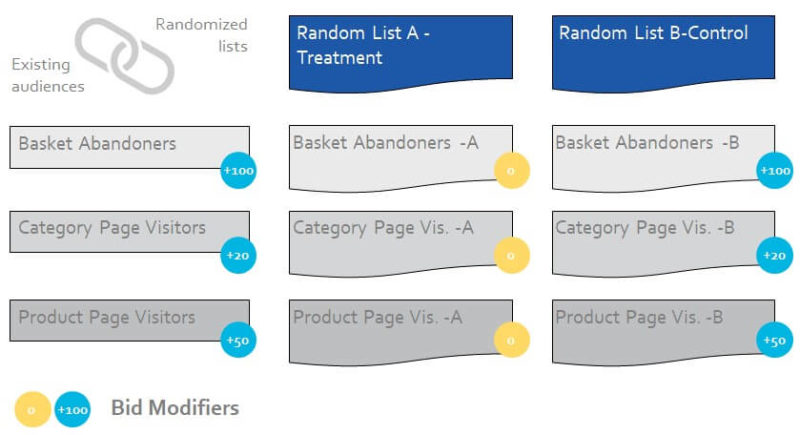
Step 4: Measure results with a custom report in Analytics
Set the “Primary Dimension” as “User Bucket.” Then, aggregate bucket performance into test groups and compare performance by several KPIs (such as Transactions, Sessions, Users or Page views). The lower the difference between the buckets excluded from AdWords and those that were pushed in AdWords, the lower the incrementality of RLSA.
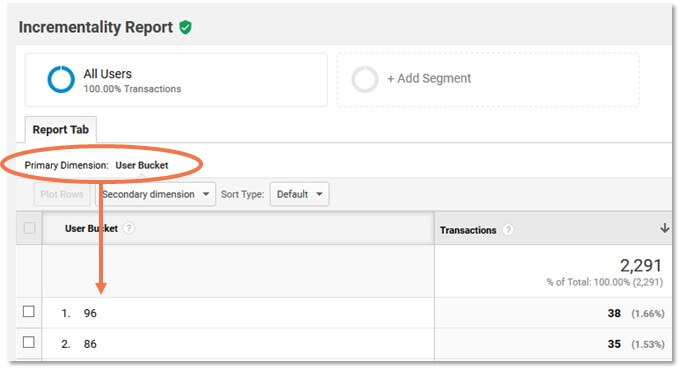
Tips and tricks to remember
Do:
- Make sure you have enough data.
- Enable Remarketing Data collection in GA (Google Analytics).
- Use -90% BM for Shopping, since negative audiences are not available.
- Avoid bid cannibalization by pausing existing RLSA lists. If you test several types of audiences, exclude these from one another — such as cart abandoners from site visitors.
Don’t:
- Mistake RLSA boosts for retargeting. As long as you don’t exclude all site visitors from all AdWords activity, you will always automatically retarget some users via PPC.
- Get too granular with your lists. To generate a valid amount of data, they should have a decent volume of users and traffic.
Brace your organization for change
Pursuing high incrementality and long-term profits means accepting lower nominal ROAS numbers (as a result of fewer eligible conversions). Keep in mind that it’s just numbers! You’re not losing out on overall revenues for your business.
Getting your data science and finance teams involved early is a smart way to set expectations across the organization. Considering KPIs that are directly aligned with business objectives, such as profit or customer lifetime value, helps avoid the vicious cycle that comes from ROAS-based objectives.
And your finance team will likely embrace this way of thinking — it’s how they get measured for success!
When you first started out using search, driving efficiency was a valid strategy. But while optimizing, it pays to be proactive… think about the next strategic step-change. New, better KPIs offer a perfect example, as they open new room for growth.
The famous management consultant Peter Drucker said something quite applicable to our over-reliance on RLSA:
Elevating your thinking on measurability and data accuracy creates a healthier and more profitable enterprise and ultimately leaves your campaign efficient and effective.
Contributing authors are invited to create content for Search Engine Land and are chosen for their expertise and contribution to the search community. Our contributors work under the oversight of the editorial staff and contributions are checked for quality and relevance to our readers. The opinions they express are their own.



